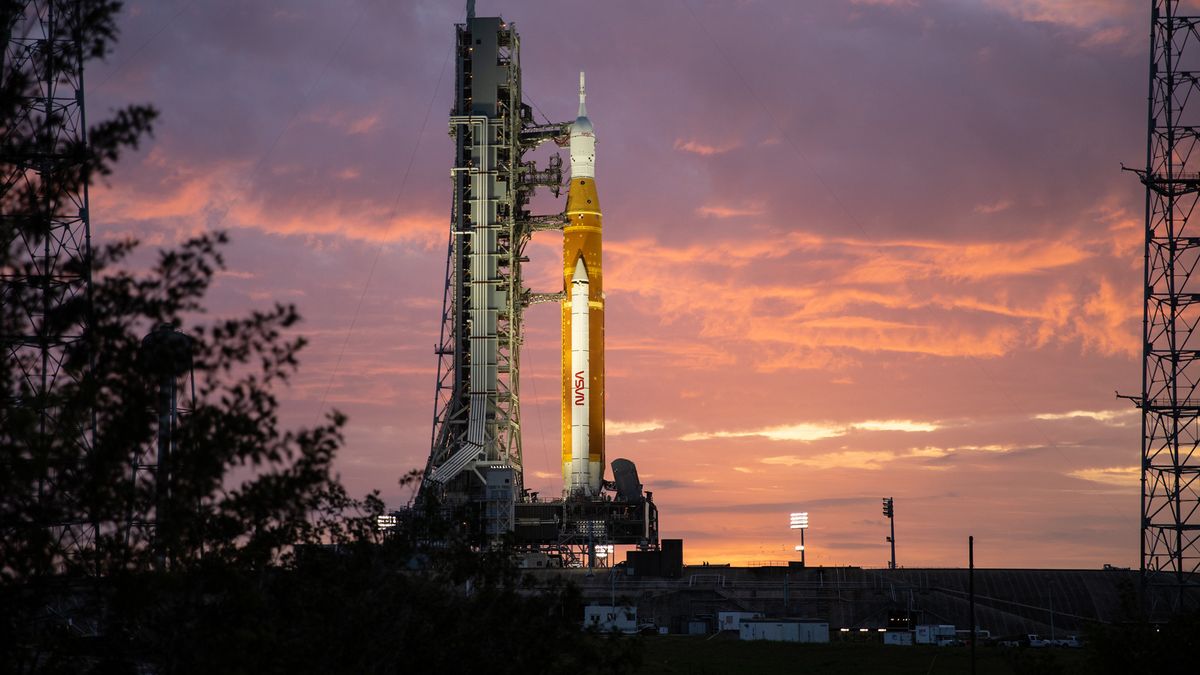NASA targeting June 19 for crucial test of Artemis 1 moon rocket
The agency aims to roll the Artemis 1 stack back out to the launch pad on June 6.

NASA plans to take another crack at a crucial fueling test of its Space Launch System (SLS) megarocket on June 19.
SLS will make its debut on the upcoming Artemis 1 mission, which will send an uncrewed Orion capsule on a journey around the moon. But before Artemis 1 can lift off, its SLS and Orion need to complete a crucial series of prelaunch tests known as a "wet dress rehearsal."
In a call with reporters on Friday afternoon (May 27), NASA officials announced that they plan to start rolling the Artemis 1 out from the huge Vehicle Assembly Building (VAB) at NASA's Kennedy Space Center (KSC) in Florida to Launch Pad 39B at around midnight EDT (0400 GMT) on June 6.
Live updates: NASA's Artemis 1 moon mission
Related: NASA's Artemis 1 moon mission explained in photos
It won't be Artemis 1's first rollout. NASA's first run at an Artemis 1 wet dress began on April 1, about two weeks after the moon rocket initially rolled out from the VAB. Following a similar timeline for vehicle checkouts at the pad this time around, NASA officials said they expect to begin the roughly 48-hour wet dress on June 19.
Several technical problems arose at the pad during last month's wet dress, including a stuck valve and a hydrogen leak in one of the "umbilical" lines connecting the SLS to its mobile launch tower. The Artemis 1 team attempted to fuel the SLS three times but ended up scrubbing the wet dress, eventually rolling the Artemis 1 stack back into the VAB for repairs on April 25.
NASA officials outlined several of these fixes during Friday's call. For the leaky umbilical, for example, it was found that flange bolts had inadvertently loosened, compromising their seal.
Get the Space.com Newsletter
Breaking space news, the latest updates on rocket launches, skywatching events and more!
"Those seals age with time," explained John Blevins, chief engineer for the SLS program at NASA's Marshall Space Flight Center in Alabama.
"We had tightened those down previously, and we hadn't done … torque checks over the period of time that we've found now that those seals age," he added. Blevins expressed confidence in the repair work, saying that Artemis 1 team members have taken steps to prevent leakage.
A helium check valve and related hardware were replaced on the SLS' upper stage, which is called the Interim Cryogenic Propulsion Stage (ICPS). Modifications were also made to the ICPS umbilical boots, which are involved in the quick disconnect between SLS and the mobile launch tower during liftoff. Additional leak detectors were also added to components of the system responsible for handling liquid hydrogen, NASA officials said
Cliff Lanham, the senior vehicle operations manager for KSC's exploration ground systems program, highlighted some of the Artemis 1 work that NASA has begun ahead of schedule thanks to the SLS rollback to the VAB. For instance, teams have partially installed payloads inside the Orion capsule and replaced the remaining ground system plates with flight plates to cover the vehicle's instrumentation. That adjustment, Lanham said, will give the vehicle better protection from Florida's hot, humid and often rainy weather, especially during the summer months.
While the SLS has been undergoing maintenance in the VAB, Pad 39B also received some needed upgrades. Part of the SLS wet dress rehearsal requires fueling and draining the rocket of propellant to simulate the procedures leading up to an actual launch. Gaseous nitrogen is used at the pad to purge the rocket's cavities and dry the umbilicals, and Pad 39B was able to receive a capacity boost over the past few weeks.
"Because it's such a big rocket, we require a proportional amount of commodities … There's a lot of different functionality on the vehicle that requires gaseous nitrogen," Tom Whitmeyer, NASA's deputy associate administrator for common exploration systems, said during Friday's call.
The increased capacity will allow SLS to undergo more extensive checks at the launch pad, including a 32-hour test-run of the nitrogen system to simulate consumption for the rocket during launch, as well as the ground systems and avionics.
"The vehicle itself is a very straightforward vehicle, but any time you get into loading operations with cryogenics, it's something that you have to take a step at a time," Whitmeyer said.
If the wet dress goes well this time around, the Artemis 1 team can start prepping for an actual liftoff. NASA officials have said that they're aiming to launch Artemis 1 this August, though they won't set an official target date until the wet dress is complete and all data have been analyzed.
Follow us on Twitter @Spacedotcom or on Facebook.
Join our Space Forums to keep talking space on the latest missions, night sky and more! And if you have a news tip, correction or comment, let us know at: community@space.com.

Josh Dinner is the Staff Writer for Spaceflight at Space.com. He is a writer and photographer with a passion for science and space exploration, and has been working the space beat since 2016. Josh has covered the evolution of NASA's commercial spaceflight partnerships and crewed missions from the Space Coast, as well as NASA science missions and more. He also enjoys building 1:144-scale model rockets and human-flown spacecraft. Find some of Josh's launch photography on Instagram and his website, and follow him on X, where he mostly posts in haiku.










